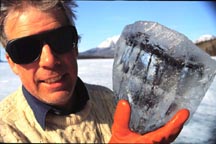">
Geotimes - November 2001 Tagish lake meteorite
Geotimes

News
Notes
Solid Earth
Reflections
on the Tagish Lake meteorite
 Remember the meteorite
that fell on Tagish Lake in Canada in January 2000? Some 70 people witnessed
the meteor streak across the sky and explode, raining debris into the remote
Yukon Territory. Since that time, scientists have clamored to study the meteorite,
hailing it the most pristine carbonaceous chondrite to date. "The meteorite
was so exciting, because it basically fell in a ready-made freezer," says
chemist Sandra Pizarello at Arizona State University. That's why she and her
colleagues were eager to analyze the specimen. Their study is one of two published
in the Sept. 21 Science that take a closer look at the chemistry and origin
of the Tagish Lake meteorite.
Remember the meteorite
that fell on Tagish Lake in Canada in January 2000? Some 70 people witnessed
the meteor streak across the sky and explode, raining debris into the remote
Yukon Territory. Since that time, scientists have clamored to study the meteorite,
hailing it the most pristine carbonaceous chondrite to date. "The meteorite
was so exciting, because it basically fell in a ready-made freezer," says
chemist Sandra Pizarello at Arizona State University. That's why she and her
colleagues were eager to analyze the specimen. Their study is one of two published
in the Sept. 21 Science that take a closer look at the chemistry and origin
of the Tagish Lake meteorite.
[University of Calgary scientist Alan
Hildebrand holds
the ice-encased meteorite
fragment. Courtesy of
University of Western Ontario and University of Calgary]
Pizarello and her colleagues analyzed the organic compounds in a 4.5-gram sample
of the Tagish meteorite. What they found was a unique chemical composition,
unlike any observed in other meteorites. "The meteorite shows a unique
chemical evolution pathway," Pizarello says.
Compared with the Murchison meteorite, a well-known specimen found in Australia
in 1969, the Tagish specimen is very simple. It seems to contain preserved organics
that accumulated in the early history of the Solar System, including bubbles
of carbon, with helium and argon in similar ratios as in the gas and dust cloud
that formed the planets. And while Murchison contains amino acids, the Tagish
specimen contains virtually none, perhaps representing an entirely separate
line of chemical evolution. Pizarello says the Tagish meteorite could untangle
the complexity surrounding most carbonaceous chondrites. She hopes it will bring
scientists one step closer to understanding the connection between chemical
prebiotic compounds and the biomolecules of the origin of life, she says.
Appearing in the same issue of Science is a very different kind of study on
the Tagish Lake meteorite. Led by Takahiro Hiroi at Brown University, the research
team analyzed the reflectance spectrum of the Tagish specimen. Hiroi says that
the Tagish specimen displayed a reflectance pattern showing it came from a D-type
asteroid, which would have originated in the cold, outer region of the asteroid
belt. "We concluded that this must be the first [carbonaceous chondrite]
identified to come from [a] D-type [asteroid]," he says. Knowing where
the approximately 4.5 billion-year-old meteorite came from, Hiroi adds, will
allow scientists to learn how the solar system formed, what materials were there
and how the materials accreted.
Lisa M. Pinsker
 Remember the meteorite
that fell on Tagish Lake in Canada in January 2000? Some 70 people witnessed
the meteor streak across the sky and explode, raining debris into the remote
Yukon Territory. Since that time, scientists have clamored to study the meteorite,
hailing it the most pristine carbonaceous chondrite to date. "The meteorite
was so exciting, because it basically fell in a ready-made freezer," says
chemist Sandra Pizarello at Arizona State University. That's why she and her
colleagues were eager to analyze the specimen. Their study is one of two published
in the Sept. 21 Science that take a closer look at the chemistry and origin
of the Tagish Lake meteorite.
Remember the meteorite
that fell on Tagish Lake in Canada in January 2000? Some 70 people witnessed
the meteor streak across the sky and explode, raining debris into the remote
Yukon Territory. Since that time, scientists have clamored to study the meteorite,
hailing it the most pristine carbonaceous chondrite to date. "The meteorite
was so exciting, because it basically fell in a ready-made freezer," says
chemist Sandra Pizarello at Arizona State University. That's why she and her
colleagues were eager to analyze the specimen. Their study is one of two published
in the Sept. 21 Science that take a closer look at the chemistry and origin
of the Tagish Lake meteorite.
